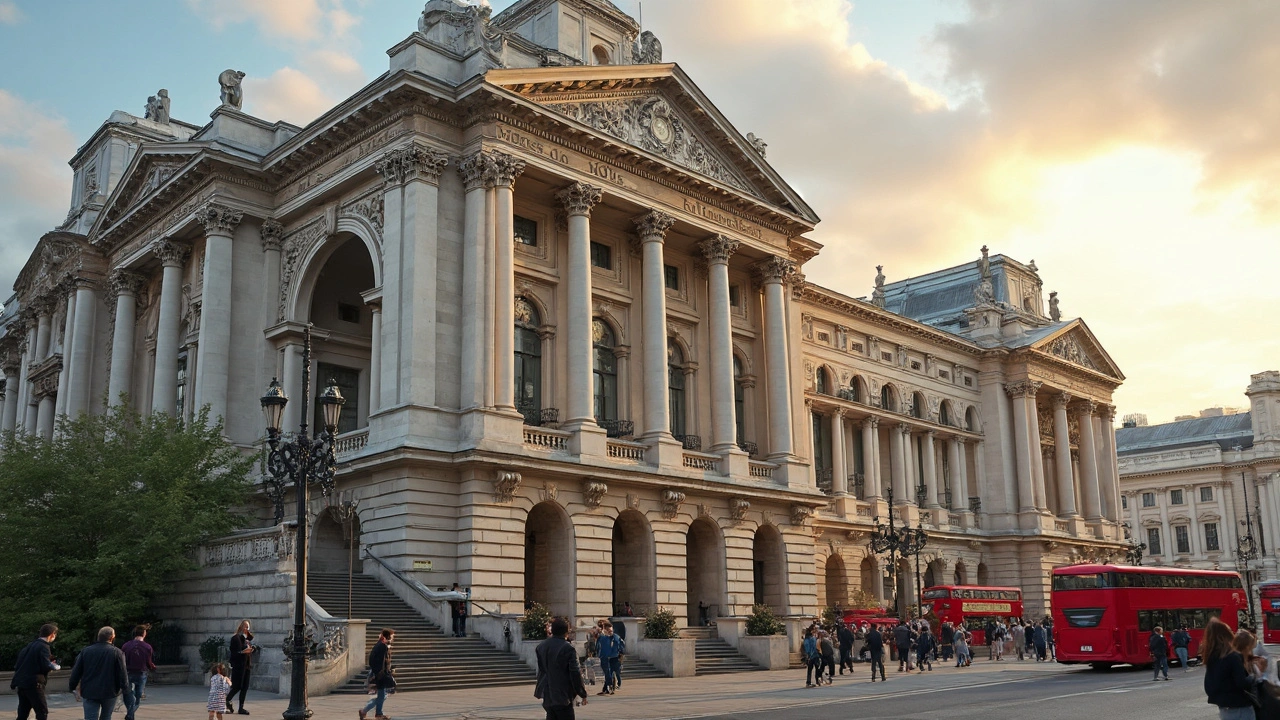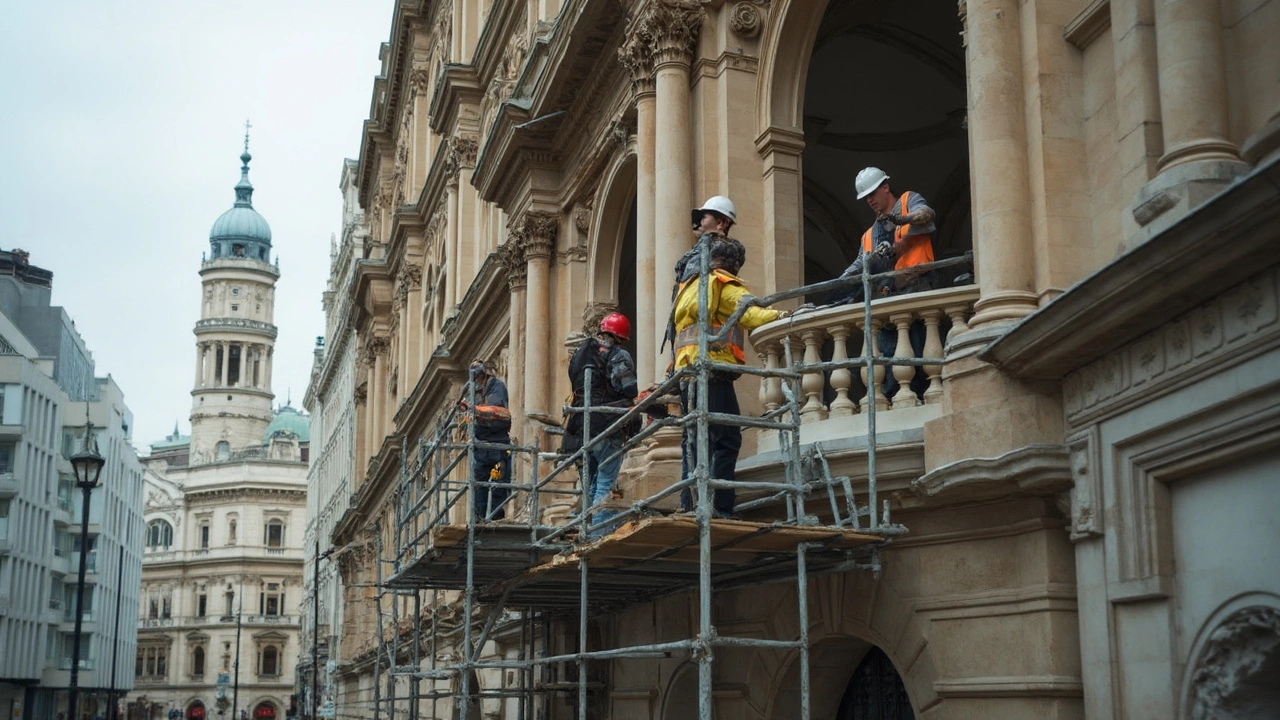Preserving Beaux-Arts Architecture: Techniques, Challenges, and Modern Impact
 Jun, 28 2025
Jun, 28 2025
You don’t have to be an architect to be wowed by Beaux-Arts buildings. Their grand staircases, sculptures, and endless decorative touches have a stubborn power: they make you stop and stare. Yet, across Australia and the world, these monumental works have become endangered. Some now stand neglected, others are barely hanging on as developers eye their prime locations. The thing is, letting them slip away isn’t just about losing some fancy facades—it’s about letting a big chunk of our cultural story vanish, piece by piece. And believe me, their survival is never guaranteed.
What Makes Beaux-Arts Architecture Stand Out?
The Beaux-Arts style sprang from Paris in the 1800s, fresh out of the École des Beaux-Arts. It’s a style that can’t help but show off: symmetry everywhere, arches galore, and ornamentation that feels almost stubbornly beautiful. Picture grand city halls, train stations with domed ceilings, and libraries you can’t help but linger in. If you’ve ever walked under a ceiling thick with gold leaf, strolled past ornate balustrades, or spotted a hidden sculpture nestled in a column, you’ve probably met Beaux-Arts. Cities like New York, Paris, Melbourne, and even Canberra show off these masterpieces, though sometimes you have to squint through scaffolding to appreciate them.
What’s especially cool about the Beaux-Arts style is how it was always meant to impress. In the last hundred years, the most important libraries, museums, and city halls were often built this way. Plenty of famous architects gave their signature touch to this form: Charles Garnier’s Paris Opera House and Daniel Burnham’s Metropolitan Museum of Art in New York are jaw-dropping examples. In Australia, places like Commonwealth Bank in Sydney or Flinders Street Station in Melbourne proudly carry the torch with their grand stairways and lavish window work.
Distinctive details set Beaux-Arts apart from any other historic style. These landmarks usually boast:
- Symmetrical facades and interior layouts
- Columns and pilasters in abundance, generally inspired by Greek or Roman forms
- Grand entrances, sometimes approached by a monumental set of stairs
- Sculpted figures, shields, and garlands winding around ledges
- Use of expensive stone, marble, and intricate ironwork
The thing about Beaux-Arts is that its beauty isn’t subtle, nor is it easy to replicate. Every cornice, every carved lion, and every bit of stained glass was handmade, based on carefully drawn plans. This kind of craftsmanship is scarce now—most modern buildings just can’t spare the budget or the time. That’s exactly why preservation feels so urgent. When you lose a Beaux-Arts building, you’re not just demolishing stone and glass. You’re waving goodbye to an entire generation’s vision of what a city should be.
Unique Challenges in Preserving Historic Beaux-Arts Buildings
If you think restoring a Beaux-Arts building is as simple as fixing a leaky roof, think again. The tough part is that every inch of these places was made to a bespoke standard. You can’t just run to the local hardware store for replacement cherubs or marble balustrades. Even tracking down the right materials—like original pink marble from Italy or hand-cast bronze—is a project on its own. Knowing how to clean a century-old stained glass ceiling without shattering it? Not something you’ll find in your average renovation course.
The first hurdle is always about money. Restoring ornate facades, custom windows, or gilded interiors takes deep pockets. Just cleaning complex sculptures stuck ten meters high can add tens of thousands to costs. Many heritage councils around the globe, including in Australia, offer grants, but red tape often slows down actual work. Private owners, meanwhile, weigh preservation costs against property values—which means some buildings end up stripped or demolished before anyone really notices.
Then there’s the technical side. Modern building codes, fire safety, and accessibility laws weren’t even a whisper when these buildings first went up. Imagine retrofitting a grand Beaux-Arts concert hall with earthquake-proofing or installing lifts for wheelchair access without damaging an original mural. Everything from heating to plumbing must fit within a structure never designed for today’s technology—the risks are huge if something goes wrong. And if you share walls with neighbours, as many city-centre Beaux-Arts buildings do, you often need delicate negotiation just to make a start.
Pollution and weather also play their part in the slow decay. Big city air has a nasty habit of eating away at the limestone and marble these buildings rely on. Acid rain, bird droppings, and years of traffic fumes stain facades and eat into statues. In places like Canberra and Melbourne, unpredictable storms can make quick work of years of careful upkeep. Conservation specialists now use everything from gentle laser cleaning to digital 3D mapping just to catalogue existing damage before they even start a single repair.
The other challenge is time. Sometimes, the urgency just isn’t there. With more pressing issues facing cities—like affordable housing or climate-change retrofits—heritage restoration can slide to the bottom of the pile. Yet, when restoration efforts lag, even a tiny unnoticed leak or forgotten broken window can spiral into catastrophic damage. Striking the balance between modernization and traditional beauty is a constant push and pull. If you’re not active about preservation, Beaux-Arts buildings lose their glory fast.

Modern Conservation Techniques and Tips
You’d be surprised at the mix of old-school know-how and high-tech magic that goes into beaux-arts architecture preservation today. The backbone of any project is always research. Conservationists map every inch of a building, using 3D lasers and advanced drones to record facades without touching them. These digital models help restoration pros figure out exactly what needs fixing, and sometimes even reveal secrets—like hidden rooms or lost murals—no one has seen in a century.
For stonework, traditional stonemasons hand-carve missing crowning features using almost the same techniques as their predecessors, but now with help from digital blueprints. When repairing stained glass or bespoke windows, they carefully match old glass recipes and glazing processes, often mixing new and recycled glass to keep the old sparkle but add a bit of modern strength. By blending the handcraft with science, builders can fix damage and improve resilience without taking away what makes these buildings special.
Want to save more than just looks? Engineers get clever with so-called ‘invisible’ upgrades. This might mean hiding new fire suppression systems within ceilings, using non-intrusive insulation behind walls, or even laser-cleaning grime and pollutants without scrubbing away delicate details. Experts are also developing reversible fixes—like temporary supports or non-permanent wall adjustments—so anything that isn’t completely faithful to the original design can be undone later. This approach protects against future mistakes, a lesson learned from past decades of botched ‘modernizations.’
There’s real community value in involving local artisans and historians, too. Many successful restoration stories come from crowdsourcing information: people’s family photo albums, diaries, or even stories passed down can unlock details you won’t find in any blueprint. Volunteers can help document original paint colors or remember what old signage looked like. Giving locals a sense of ownership over the project means you build public support—and often fundraising momentum—right where it counts.
If you ever want to pitch in personally, there are some practical ways:
- Join local heritage walks and advocate for endangered sites.
- Support crowdfunding or heritage grant campaigns targeted at restoration projects.
- If you live near a Beaux-Arts building, keep a virtual eye on its upkeep and alert councils to neglect or vandalism.
- Donate photos, family stories, or ephemera to archives tracking these buildings’ histories.
Why the Beaux-Arts Legacy Matters Today
People sometimes ask, why spend so much on buildings from another era? But each Beaux-Arts landmark is a time capsule, full of the design quirks and ambitions of those who built them. They also anchor neighbourhoods—when developers flatten these for anonymous glass towers, the whole area starts feeling rootless. Think about cities like Paris or Melbourne. Without their historic stations, museums, or arcades, they’d be completely different places, don’t you think?
New studies from Australian heritage groups do show that well-preserved Beaux-Arts sites drive up foot traffic and spending in surrounding areas. Tourists flock to old railway stations and grand hotels, not just the shiny new districts. Well-preserved heritage zones create jobs, support local craftspeople, and encourage city dwellers to walk instead of drive. It’s not just nostalgia driving these benefits—there’s hard data backing up the case for keeping these old beauties alive.
Modern architects are also taking notes from Beaux-Arts classics. You now see new buildings borrowing symmetry, decorative stonework, or grand entrances to tap into the emotional punch these old forms deliver. The style’s strong bones let us read a city’s history as we pass through. Schools, libraries, and even restaurants reach for Beaux-Arts cues to invite people in and create a sense of occasion. It’s a reminder that good design lasts, and the best ideas don’t always need to be reinvented every decade.
Here in Australia, Beaux-Arts preservation sparks feisty debates, especially as downtown zones get denser. The trick is to protect what’s left and reimagine it for modern uses. Adaptive reuse—converting banks into tech hubs, or gasworks into thriving art venues—keeps buildings from becoming frozen museum pieces. Cities that learn to blend the past and present give us all more interesting places to live, work, and play.
If you’re passing by one of these landmark buildings, take a minute to check the details: a carved head, a swirling iron stair, the tiny signature of a craftsman tucked in a cornice. That’s the heart of Beaux-Arts—the idea that our built environment should dazzle, last, and surprise, no matter how many decades go by.